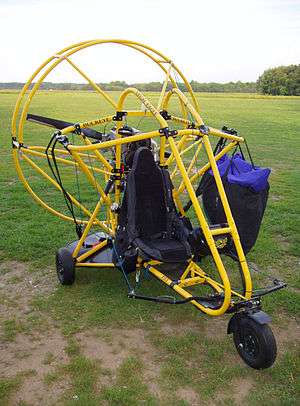Buckeye Eagle
The Buckeye Eagle is an American powered parachute that was designed and produced by Buckeye Industries of Argos, Indiana.[1][2]
| Eagle | |
|---|---|
 | |
| Buckeye Eagle with wing stowed in a bag | |
| Role | Powered parachute |
| National origin | United States |
| Manufacturer | Buckeye Industries |
| Status | Production completed |
| Unit cost |
US$9,113.88 (kit, 1998) |
Design and development
The aircraft was designed to comply with the US FAR 103 Ultralight Vehicles rules, including the category's maximum empty weight of 254 lb (115 kg). The aircraft has a standard empty weight of 220 lb (100 kg). It features a parachute-style high-wing, single-place accommodation, tricycle landing gear and a single 40 hp (30 kW) Rotax 447 engine in pusher configuration. The 50 hp (37 kW) Rotax 503 engine was a factory option.[1][2]
The Eagle is built from a combination of bolted aluminium and 4130 steel tubing. In flight steering is accomplished via foot pedals that actuate the canopy brakes, creating roll and yaw. On the ground the aircraft has lever-controlled nosewheel steering. The main landing gear incorporates spring rod suspension. The aircraft was factory supplied in the form of an assembly kit that requires 30–40 hours to complete.[1][2]
The Eagle has a conversion kit that allows exchanging the parachute wing for a hang glider-style wing to convert the aircraft into an ultralight trike.[1]
With the parachute wing, the standard day, sea level, no wind, take off with a 50 hp (37 kW) engine is 300 ft (91 m) and the landing roll is 100 ft (30 m).[2]
Specifications (Eagle)
Data from Cliche and Purdy[1][2]
General characteristics
- Crew: one
- Wing area: 450.0 sq ft (41.81 m2)
- Empty weight: 220 lb (100 kg)
- Gross weight: 550 lb (249 kg)
- Fuel capacity: 5 U.S. gallons (19 L; 4.2 imp gal)
- Powerplant: 1 × Rotax 447 twin cylinder, two-stroke, air-cooled aircraft engine, 40 hp (30 kW)
Performance
- Maximum speed: 26 mph (42 km/h, 23 kn)
- Cruise speed: 26 mph (42 km/h, 23 kn)
- Service ceiling: 10,500 ft (3,200 m)
- Rate of climb: 800 ft/min (4.1 m/s)
- Wing loading: 1.2 lb/sq ft (5.9 kg/m2)
References
| Wikimedia Commons has media related to Buckeye Eagle. |
- Cliche, Andre: Ultralight Aircraft Shopper's Guide 8th Edition, page D-3. Cybair Limited Publishing, 2001. ISBN 0-9680628-1-4
- Purdy, Don: AeroCrafter - Homebuilt Aircraft Sourcebook, Fifth Edition, page 336. BAI Communications, 15 July 1998. ISBN 0-9636409-4-1